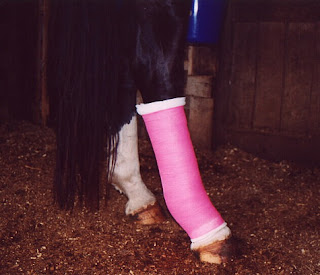"Why didn't she just say that everyone would find this post entertaining?"
I would like to introduce you non-horsey folks to a concept called, "The Modified Robert Jones Bandage." A modified Robert Jones bandage is the single most common bandage used in the equine hospital.
These are your materials, and they are applied in the following order;
 |
| 1) Combi roll or thick roll cotton |
 |
| 2) Brown Gauze |
 |
| 3) Vetrap |
 |
| 4) +/- Elastikon |
Most horses are very used to having a wrap or boot of some kind on their leg. Sometimes they are placed for shipping, as in the case of this fashionable little fellow . . .
. . . and most commonly for protection during exercise . . . .
Still, while most horses are used to some sort of bandage on the lower portion of their leg, they are often unaccustomed to having a bandage on the upper, or proximal portion, of the limb.
This is where our story begins;
The majestic horse. . . .
Graceful. . . .
Elegant. . . .
Athletic. . .
and completely accident prone.
There is a saying that if you place a horse in a padded room, he will find a way to hurt himself and it is 100% truth. I attribute a great deal of that truth to the fact that horses are prey animals, and as such, their first instinct is to run. Unfortunately, if you are living in a 12x12 box stall, there isn't a whole lot of room to run. Yah, those walls come up pretty quick. The majority of horses that I see injured in a truly traumatic event, who are also kept out on a large pasture, are injured by barbed wire. I don't blame that on the horse. I blame it on the wire.
So what happens when a horse injures their carpus (knee)?
or tarsus/hock (ankle)?
Well that's when you have to place a STACK BANDAGE. A stack bandage is just one modified robert jones placed above another, in an ascending fashion, with some overlap of the bandages. This does several things. It covers the affected area and it also decreases the mobility in the limb. This is particularly important if you have a wound over a high motion area or a joint, like this one on the dorsal (front) aspect of a horse's hock. . .
The problem with these bandages is that you are taking a flight animal and essentially immobilizing or greatly reducing the mobility of one of their legs. How well do you think that goes over? Well it goes over something like this. . .
First, the horse is sedated to apply the bandage. I call this the "blissfully unaware" stage.
 |
| Stage 1: Blissfully Unaware |
Secondly, as the sedation begins to wear off the horse enters stage 2 or the "Recognition" stage.
 |
| Stage 2: Recognition |
Thirdly, the sedation is blasted off its receptors by a surge of adrenaline and the horse enters the third, "Escape" stage.
 |
| Stage 3: ESCAPE! |
Stage 3 or "Escape" stage, can go on for a prolonged period of time. The horse seems to be convinced that there is a lion or bear attached to its leg. Rather than attempting to use the limb, it chooses holding the leg up at a nearly 90 degree angle to its body, which inevitably causes it to fall away in the opposite direction.
I have literally seen entire rooms destroyed by a horse in the "Escape" stage as it levitates its limb around the room while simultaneously trying to run away from it. The best thing to do is to try and get these horses moving forward. There are rare occasions where a horse does not make it past "Escape" stage and the bandage has to be modified further.
However, most horses at least make it to their stalls, where they enter the fourth stage, "Resignation" stage.
 |
| Stage 4: Resignation |
Horses in "Resignation" stage may be resigned to the situation, but they are still convinced that there is a lion attached to their leg. Horses in this stage often will not move, even for food, and it is important to make sure they are within reach of food and water. Upon moving, "Resignation" horses may lapse back to the "Escape" phase, as they are further reminded of the bear on their hind limb.
Then one magical day, you walk into the stall and the horse is walking around and acting like nothing ever happened.
It can be frustrating working with these horses. Here you are trying to immobilize their limb and they are doing acrobatic feats just to get away from your stack wrap. Its important to remember that they are a flight animal and that they simply don't understand. Everyone gets frustrated with them at times. Especially when you take the magic worm-hole and go straight from stage 1 "blissful ignorance" to stage 3 "Escape" in the middle of trying to wrap the leg. Usually in these moments all the bandaging material goes flying, becomes ripped or falls to the ground and you are left to start all over again. Still, if it wasn't challenging, anyone could do it right?
That's why we became horse vets right?!
We bandage the unbandagable!
Until next time!






